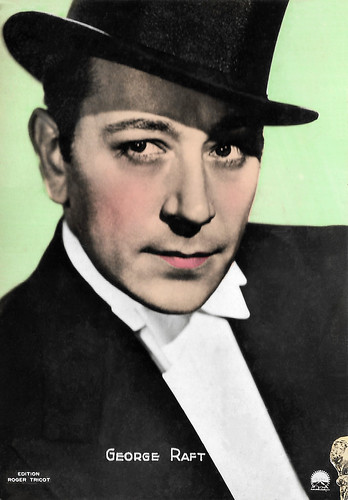
French collectors card by Edition Roger Tricot. Photo: Paramount.
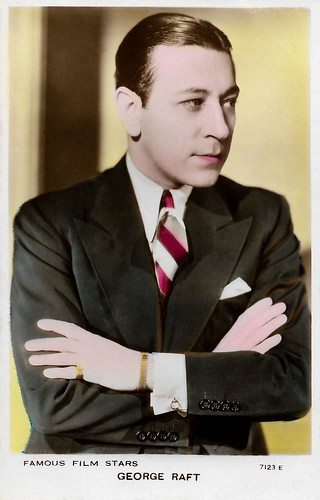
British postcard by Art Photo in the Famous Film Stars series, no. 7123 E. Caption: George Raft - Born 27th September, 1903, in New York City. Black hair, brown eyes. Height 5ft, 10 Ins. In his teens was professional fly-weight boxer. Later took up professional dancing. Has stage experience before coming to the screen. Films include: 'The Trumpet Blows', 'Limehouse Blues', 'Rumba', 'Every Night at Eight' and 'The Woman Tamer'.
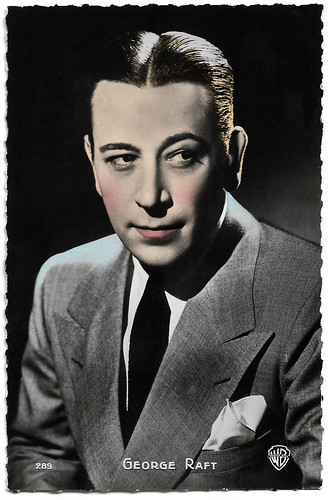
French postcard by Editions P.I., Paris, no. 289, presented by Les Carbones de France, Paris. Photo: Warner Bros.
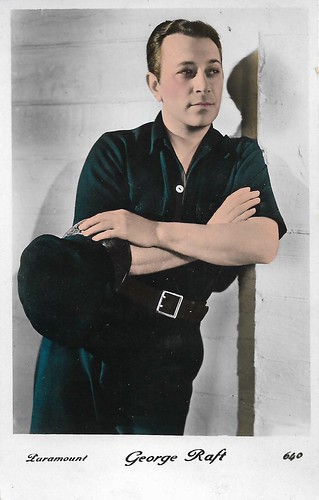
French postcard, no. 460. Photo: Paramount. George Raft in Spawn of the North (Henry Hathaway, 1938).

British postcard by Art Photo, no. 173. Sylvia Sidney and George Raft in You and Me (Fritz Lang, 1938).
Hell's Kitchen
George Raft was born George Ranft in New York in 1901. He was the eldest of ten children of German immigrant Conrad Ranft and his wife Eva Glockner. His parents worked as dancers in New York nightclubs. George Raft spoke fluent German, which he had learned from his parents.
George grew up in poor circumstances in Hell's Kitchen, at the time one of the roughest, meanest areas of New York City. In his childhood, he befriended the later mobsters Bugsy Siegel and Owney Madden, who grew up in the same neighbourhoods as he did. The friendship between Siegel and Raft lasted a lifetime, with Raft making Siegel acquaintances in Hollywood and using his popularity to support him in courtroom prosecutions.
Raft ran away from home at the age of 13. In his younger years, he tried his hand as a boxer, taxi driver and nightclub dancer. His success as a dancer in New York nightclubs led him to Broadway, where he also worked as a dancer. Fred Astaire, in his autobiography 'Steps in Time' (1959), said Raft was "the neatest, fastest Charleston dancer ever. He practically floored me with his footwork."
George Raft married Grayce Mulrooney in 1923 but soon after they would divorce. Grayce, a devout Catholic, refused Raft a divorce, however, and he remained married to her until her death in 1970.
Raft later had several relationships with Betty Grable and Mae West. He appeared with Mae West in both her first film, Night After Night (Archie Mayo, 1932) and her last film, Sextette (Ken Hughes, 1977). He openly declared that he wanted to marry Norma Shearer, but his wife's refusal to divorce meant that his wedding plans came to nothing.

British postcard in the Film Shots series by Film Weekly. Photo: 20th Century. Fay Wray and George Raft on the beach in the pre-Code movie The Bowery (Raoul Walsh, 1933), distributed by United Artists.

British postcard in the Film Shots series by Film Weekly. Photo: Paramount. Sylvia Sidney and George Raft in Pick-up (Marion Gering, 1933).
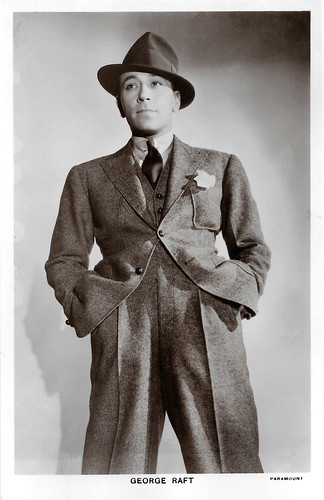
British postcard in the Picturegoer Series, London, no. 1018. Photo: Paramount.
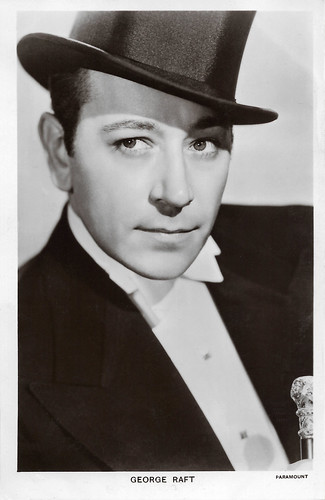
British postcard in the Picturegoer Series, London, no. 1018a. Photo: Paramount.

French postcard by E.C. (Edition Chantal), no. 8. Photo: Paramount.
An ideal gangster on the silver screen
George Raft moved to Hollywood in 1929 and first played small roles there. His success came in Scarface (Howard Hawks, 1932). He played Guino Rinaldo, the aspiring gangster partner of Paul Muni, who is ultimately killed by him because of an affair with his sister. Raft's charisma made him an ideal gangster on the silver screen.
Raft solidified his reputation as a movie star in the 1930s with crime and gangster films such as The Glass Key (Frank Tuttle, 1935). In 1938 he played the male lead in You and I, directed by Fritz Lang. He was one of the most popular actors in gangster roles of the 1930s, with James Cagney and Edward G. Robinson.
Raft and Cagney worked as convicts in a prison in Each Dawn I Die (William Keighley, 1939). From 1945 his popularity waned and from then on he was mostly seen as the lead in B-movies in Film Noir style. He also took leading roles in European films. In the 1950s, Raft, along with Kosher-Nostra head Meyer Lansky and mob boss Santo Trafficante, opened the Capri Casino in Havana, which was initially financially successful. However, he lost it in 1959 to the revolution in Cuba.
In 1965, Raft was accused of tax evasion because of his financial problems. However, he got off with a suspended sentence as he pleaded guilty. In 1967, Britain banned him from entering the country because of his Mafia contacts. One of his best-known later film appearances was in the comedy classic Some Like It Hot (Billy Wilder, 1959), where he played the gangster boss "Spats Colombo" in a parody of his usual roles. Some Like It Hot became one of Raft's last major film appearances.
In the 1960s and 1970s, the veteran star mostly had to settle for cameo appearances. Raft's last film Sam Marlow, Private Detective (Robert Day, 1980) was released in the last year of his life and was a tribute to his former co-star Humphrey Bogart. George Raft died of leukaemia in Los Angeles in November 1980 at the age of 79. He was buried in Forest Lawn Memorial Park.
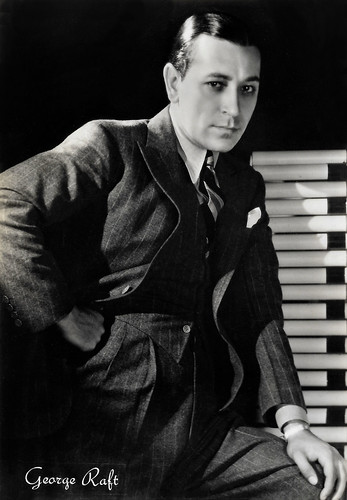
Italian postcard by Rotalfoto, Milano, no. 34.
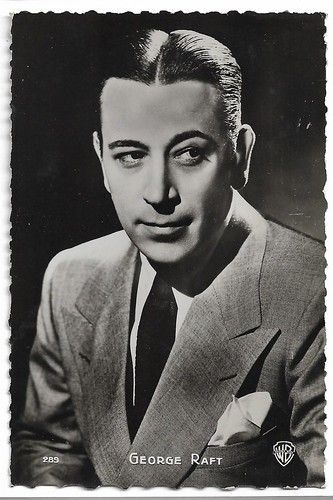
French postcard by Editions P.I., Paris, no. 289. Photo: Warner Bros.
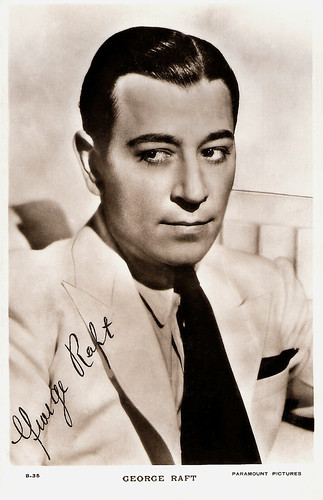
British Real Photograph postcard, no. B.35. Photo: Paramount Pictures.
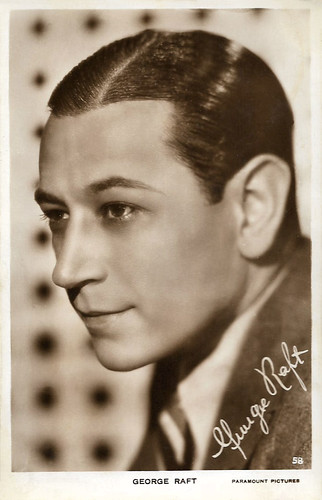
British postcard, no. 58. Photo: Paramount Pictures.
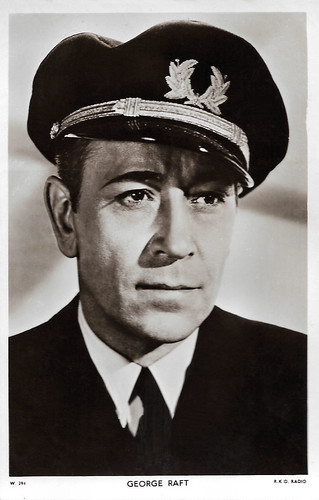
British postcard in the Picturegoer Series, London, no. W 294. Photo: R.K.O. Radio. George Raft in Johnny Angel (Edwin L. Marin, 1945).
Sources: Ken Yousten (IMDb), Wikipedia (Dutch and English) and IMDb.
No comments:
Post a Comment